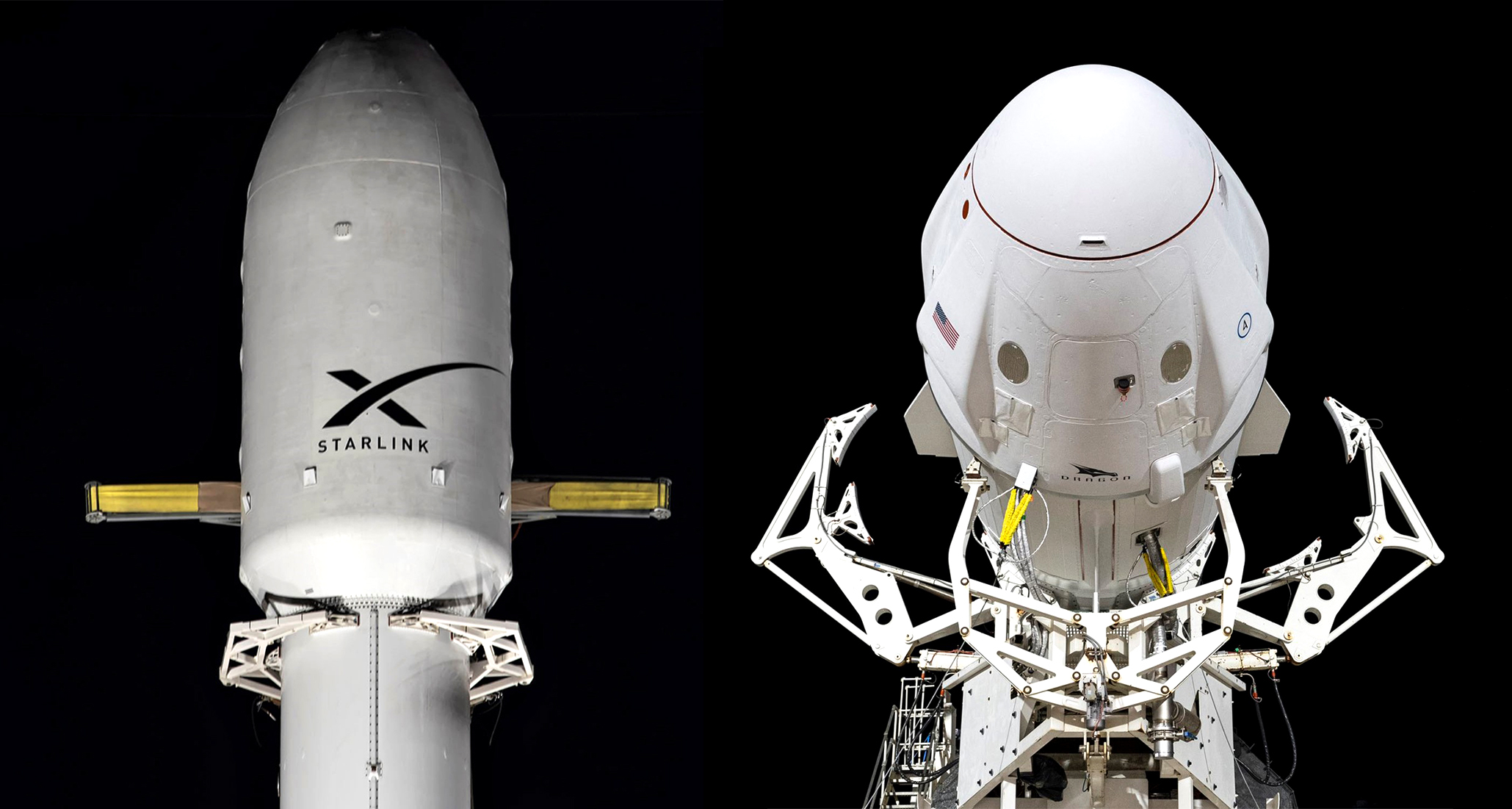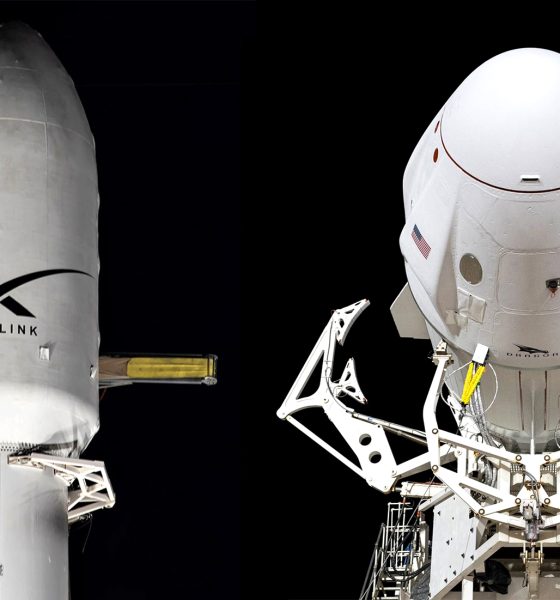

News
SpaceX to launch Crew Dragon and Starlink satellites less than 48 hours apart
After launching just once in the last ten weeks, SpaceX appears to be set to return to H1 2021 stride and has scheduled the launches of a historic all-private Crew Dragon mission and the first batch of laser-linked Starlink ‘V1.5’ satellites less than 48 hours apart.
First up, SpaceX is on track for its first dedicated Starlink launch in almost four months (~16 weeks) – this time carrying upgraded V1.5 spacecraft – as early as 8:55 pm PDT, Monday, September 13th (03:55 UTC 14 Sept). Aside from quite possibly marking the last time ever that SpaceX goes 3+ months without a Starlink launch, the “Starlink 2-1” mission will be the company’s first West Coast launch in ten months and first West Coast Starlink launch ever.
As few as ~44 hours later, SpaceX is now fully ready to launch both Dragon’s and the world’s first crew of all-private astronauts into the highest orbit reached by humans since 2009 no earlier than 8:05 pm EDT, Wednesday, September 15th (00:05 UTC 16 Sept). Known as Inspiration4, there is a real chance that the mission could mark a turning point for the future of true orbital space tourism and will be the first of at least four or five private Crew Dragon launches scheduled in the next few years.
Both missions will mark important technical milestones in their own right. As previously discussed on Teslarati, Inspiration4 will launch on a twice-flown Falcon 9 booster and with a Dragon space capsule that was in orbit less than five months prior, setting new records for crewed booster reuse and orbital space capsule turnaround. Its all-private four astronaut crew (also a first in spaceflight history) will reach altitudes as high as 575 km (357 mi) – the highest humans have traveled since 2009 and the seventh-highest crewed Earth orbit spaceflight of all time.

On the opposite side of the United States, SpaceX is also gearing up for the dedicated launch of a batch of 51 ‘Starlink V1.5’ satellites. Known as Starlink 2-1 or Starlink Group 2-1, the mission will mark the start of a new ‘shell’ of SpaceX’s low Earth orbit (LEO) Starlink constellation, the first dedicated Starlink launch since May 26th, the first dedicated Starlink launch with laser-linked spacecraft, and SpaceX’s first West Coast launch since November 2020. Additionally, Starlink 2-1 will launch on a nine-flight Falcon 9 booster – the second time a SpaceX rocket has completed ten orbital-class launches and landings if all goes to plan.
Originally scheduled to launch as early as July, SpaceX is believed to have delayed Starlink 2-1 until the design and production of upgraded V1.5 satellites were ready to support the 51-satellite launch. Until SpaceX or its CEO provide more information, all that’s known about the new V1.5 design is that its main focus was the addition of inter-satellite optical links (laser links). Those ‘space lasers’ are designed to allow Starlink satellites to route communications themselves, enabling potentially unbeatable latency, internet coverage over oceans and extremely sparse regions, and a network that doesn’t need line-of-sight ground stations to function.

Technically, SpaceX has already launched 13 Starlink satellites with laser links and has been testing those spacecraft for the last 2-9 months, hopefully meaning that the V1.5 satellites SpaceX launches later today will be more reliable than their first-of-their-kind Starlink V0.9 and V1.0 cousins. Tune in at SpaceX.com around 8:40 pm PDT (03:40 UTC) to catch the company’s live Starlink 2-1 webcast.

News
Tesla FSD fleet is nearing 7 billion total miles, including 2.5 billion city miles
As can be seen on Tesla’s official FSD webpage, vehicles equipped with the system have now navigated over 6.99 billion miles.

Tesla’s Full Self-Driving (Supervised) fleet is closing in on almost 7 billion total miles driven, as per data posted by the company on its official FSD webpage.
These figures hint at the massive scale of data fueling Tesla’s rapid FSD improvements, which have been quite notable as of late.
FSD mileage milestones
As can be seen on Tesla’s official FSD webpage, vehicles equipped with the system have now navigated over 6.99 billion miles. Tesla owner and avid FSD tester Whole Mars Catalog also shared a screenshot indicating that from the nearly 7 billion miles traveled by the FSD fleet, more than 2.5 billion miles were driven inside cities.
City miles are particularly valuable for complex urban scenarios like unprotected turns, pedestrian interactions, and traffic lights. This is also the difference-maker for FSD, as only complex solutions, such as Waymo’s self-driving taxis, operate similarly on inner-city streets. And even then, incidents such as the San Francisco blackouts have proven challenging for sensor-rich vehicles like Waymos.
Tesla’s data edge
Tesla has a number of advantages in the autonomous vehicle sector, one of which is the size of its fleet and the number of vehicles training FSD on real-world roads. Tesla’s nearly 7 billion FSD miles then allow the company to roll out updates that make its vehicles behave like they are being driven by experienced drivers, even if they are operating on their own.
So notable are Tesla’s improvements to FSD that NVIDIA Director of Robotics Jim Fan, after experiencing FSD v14, noted that the system is the first AI that passes what he described as a “Physical Turing Test.”
“Despite knowing exactly how robot learning works, I still find it magical watching the steering wheel turn by itself. First it feels surreal, next it becomes routine. Then, like the smartphone, taking it away actively hurts. This is how humanity gets rewired and glued to god-like technologies,” Fan wrote in a post on X.
News
Tesla starts showing how FSD will change lives in Europe
Local officials tested the system on narrow country roads and were impressed by FSD’s smooth, human-like driving, with some calling the service a game-changer for everyday life in areas that are far from urban centers.

Tesla has launched Europe’s first public shuttle service using Full Self-Driving (Supervised) in the rural Eifelkreis Bitburg-Prüm region of Germany, demonstrating how the technology can restore independence and mobility for people who struggle with limited transport options.
Local officials tested the system on narrow country roads and were impressed by FSD’s smooth, human-like driving, with some calling the service a game-changer for everyday life in areas that are far from urban centers.
Officials see real impact on rural residents
Arzfeld Mayor Johannes Kuhl and District Administrator Andreas Kruppert personally tested the Tesla shuttle service. This allowed them to see just how well FSD navigated winding lanes and rural roads confidently. Kruppert said, “Autonomous driving sounds like science fiction to many, but we simply see here that it works totally well in rural regions too.” Kuhl, for his part, also noted that FSD “feels like a very experienced driver.”
The pilot complements the area’s “Citizen Bus” program, which provides on-demand rides for elderly residents who can no longer drive themselves. Tesla Europe shared a video of a demonstration of the service, highlighting how FSD gives people their freedom back, even in places where public transport is not as prevalent.
What the Ministry for Economic Affairs and Transport says
Rhineland-Palatinate’s Minister Daniela Schmitt supported the project, praising the collaboration that made this “first of its kind in Europe” possible. As per the ministry, the rural rollout for the service shows FSD’s potential beyond major cities, and it delivers tangible benefits like grocery runs, doctor visits, and social connections for isolated residents.
“Reliable and flexible mobility is especially vital in rural areas. With the launch of a shuttle service using self-driving vehicles (FSD supervised) by Tesla in the Eifelkreis Bitburg-Prüm, an innovative pilot project is now getting underway that complements local community bus services. It is the first project of its kind in Europe.
“The result is a real gain for rural mobility: greater accessibility, more flexibility and tangible benefits for everyday life. A strong signal for innovation, cooperation and future-oriented mobility beyond urban centers,” the ministry wrote in a LinkedIn post.
News
Tesla China quietly posts Robotaxi-related job listing
Tesla China is currently seeking a Low Voltage Electrical Engineer to work on circuit board design for the company’s autonomous vehicles.

Tesla has posted a new job listing in Shanghai explicitly tied to its Robotaxi program, fueling speculation that the company is preparing to launch its dedicated autonomous ride-hailing service in China.
As noted in the listing, Tesla China is currently seeking a Low Voltage Electrical Engineer to work on circuit board design for the company’s autonomous vehicles.
Robotaxi-specific role
The listing, which was shared on social media platform X by industry watcher @tslaming, suggested that Tesla China is looking to fill the role urgently. The job listing itself specifically mentions that the person hired for the role will be working on the Low Voltage Hardware team, which would design the circuit boards that would serve as the nervous system of the Robotaxi.
Key tasks for the role, as indicated in the job listing, include collaboration with PCB layout, firmware, mechanical, program management, and validation teams, among other responsibilities. The role is based in Shanghai.
China Robotaxi launch
China represents a massive potential market for robotaxis, with its dense urban centers and supportive policies in select cities. Tesla has limited permission to roll out FSD in the country, though despite this, its vehicles have been hailed as among the best in the market when it comes to autonomous features. So far, at least, it appears that China supports Tesla’s FSD and Robotaxi rollout.
This was hinted at in November, when Tesla brought the Cybercab to the 8th China International Import Expo (CIIE) in Shanghai, marking the first time that the autonomous two-seater was brought to the Asia-Pacific region. The vehicle, despite not having a release date in China, received a significant amount of interest among the event’s attendees.








